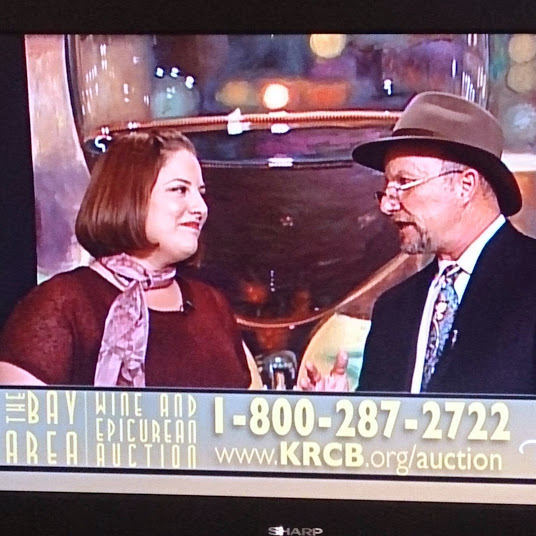In 2014, I had the privilege to interview three visual artists: Ken Berman of Sebastopol, Peggy Sebera of Petaluma, and Willow LaLand-Yeilding of Healdsburg. These generous and talented artists provided beautiful backdrops that dramatically increased the production value of KRCB’s fundraising auction events, broadcast live to the San Francisco-Oakland-San Jose market in April, June, and October.

Auction hosts Briana Gordon and Tom Silberkleit stand in front of Willow LaLand-Yeilding’s painting of “Evening” on Saturday, October 17, 2014.
Each interview lasted about 30-40 minutes and were edited into 2-3-minute segments; each segment aired at least 18 times over the course of the 68 hours of live TV that were produced in 2014. The October event coincided with the annual Sonoma County ARTtrails event so the Sebera and LaLand-Yeilding interviews were also used to promote the wine country art community in general.
Even though production constraints prevented KRCB from filming the artists in their home studios, the works of art themselves proved to be a vibrant visual to accompany these stories; nonetheless, with significant interview footage left on the cutting room floor, waxman.TV looks forward to creating extended artist profiles, in partnership with the artists and organizations like the Sebastopol Center for the Arts (the organization that organizes ARTtrails).

 Dolman lives and works at the
Dolman lives and works at the  “If their population lacks resiliency,” he explains, “then it is really an indicator about the land use in that place.”
“If their population lacks resiliency,” he explains, “then it is really an indicator about the land use in that place.” Imagine the Petaluma River Watershed as a massive bowl—Wick and Rogers live on opposite rims. From their perspective, they see first-hand what their actions have on the river downstream.
Imagine the Petaluma River Watershed as a massive bowl—Wick and Rogers live on opposite rims. From their perspective, they see first-hand what their actions have on the river downstream. The lower Petaluma isn’t really a river, but rather, a tidal estuary. In fact much of the Bay Area’s shoreline once looked a lot like the Petaluma River estuary, where 12 miles of tidal sloughs still twist and turn through scenic places like Shollenberger Park.
The lower Petaluma isn’t really a river, but rather, a tidal estuary. In fact much of the Bay Area’s shoreline once looked a lot like the Petaluma River estuary, where 12 miles of tidal sloughs still twist and turn through scenic places like Shollenberger Park. Bill Long, a longtime resident of Novato, has studied the history of the region. “The creek was the central feature of this valley,” he says. “It’s where the Native Americans gathered and it’s where wildlife gathered. When the area was developed, much of the creek ended up in people’s back yards”
Bill Long, a longtime resident of Novato, has studied the history of the region. “The creek was the central feature of this valley,” he says. “It’s where the Native Americans gathered and it’s where wildlife gathered. When the area was developed, much of the creek ended up in people’s back yards” “After World War II,” notes Chris DeGabrielle, “Novato was growing rapidly, and the well water supply couldn’t keep up.” That’s one reason why, in 1951, Stafford Lake was formed behind a dam constructed on the creek.
“After World War II,” notes Chris DeGabrielle, “Novato was growing rapidly, and the well water supply couldn’t keep up.” That’s one reason why, in 1951, Stafford Lake was formed behind a dam constructed on the creek.